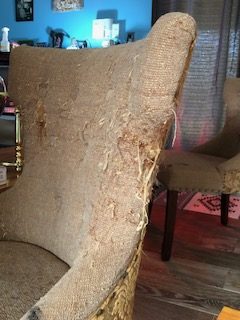
Nail Care
We recently received an email: We need to clip our cat’s nails and are always afraid of going to close. We have never actually done it and have had your staff do it when she has been in for a checkup. How can we get over the fear of clipping to close?
Nail care is a very important part of your cat’s daily routine, when you observe a cat grooming, one of the things they will do is pick at their nails. Think of the nail as an onion with many layers. When they are picking at their nails, they are removing the dead covering to reveal the new sharp underlayer. These new sharp claws allow them to protect themselves from larger predators, capture and kill prey, mark their territory and of course help customize your furniture.
Nail trimming does not have to be a stressful event for you or your cat, but it does take some training and patience to prepare your cat to have their nails cut. First a little behavior lesson: It is important to understand that scratching is normal behavior for cats, which has an inherent function. The primary reason cats scratch is to maintain the necessary claw motion used in hunting and climbing, as well as a means to stretch their body. Scratching serves to groom the front claws and leave markers, from scent glands between their toes, of the cat’s presence.
Regularly trimming your cat’s claws can prevent injury and damage to household items. Proper feline nail trimmers should be used to prevent splintering of the claws. The frequency of claw trimming will depend on your cat’s lifestyle. Indoor cats, kittens, and older cats will need more regular nail trims, whereas outdoor cats may naturally wear down their nails requiring less frequent trimming. If possible, start trimming as kittens so they become comfortable with the process early on. If your cat does not like claw trimmings start slow, offer breaks, and make it a familiar routine. Always trim claws in a calm environment and provide positive reinforcement. Proper training to scratch on appropriate surfaces, combined with nail care, can prevent damage in the home.
A quick word about declawing: In July 2020, New York became the first state to prohibit declawing for non-medical reasons. Declawing is a procedure where the first knuckle of the foot is removed. Besides being a painful procedure, we do see changes in the way cats walk and jump and can lead to arthritic changes later in life. There are many options to declawing including training your cat to use the scratching post, when your cat uses a chair or other object to scratch, gently move them to the scratching post and giving them a reward when they use the post. Do not yell, scream or throw things at them, our goal is to use a positive reward after you redirect them to the appropriate location. Other options include temporary synthetic nail covers which are attached to your cat’s nails with surgical glue, but do need to be changed as the nail grows and pushes the cover off. Providing an environmental that is enriching and challenging to your cat will also teach them to scratch at appropriate areas. By trying to mimic your cat’s natural behaviors you can train your cats to use appropriate areas, for example, cats love to pounce, try a toy attached to a string and dangle it over the post, your cat will attack the toy and scratch the post, be sure to reward this behavior.
Now to the nail trimming, first a little anatomy. If you hold your cats’ foot, and apply light pressure to the last knuckle the toe nail will become exposed. With cats, we are lucky that the nails are mostly clear and we are able to see the structures within the nail. At the base of the nail, you will see a dark area that may appear pink. This is the “quick” a combination of blood vessel and nerve, this is the area we want to avoid.
Some equipment that you will need: treats – something your cat really loves like tuna or a piece of fish that can be flaked into very small pieces, a sharp nail trimmer – hopefully one designed for cats, a quiet environment – it is best not to try this while you are cooking dinner, the dogs are barking and the kids are screaming, and styptic powder or pencil- this is just in case you do cut the nail too short and get some blood. I have never heard of or seen a cat have any significant bleeding from a nail trim. And last, a helper.
While the holder is holding and distracting the cat with treats, you will hold the foot and expose the nail, visually locate the quick and cut just in front of the dark area. In some cases, it may help to wrap your cat in a towel. Never force the clipping on your cat, it will only reinforce their fear of the procedure and make it much harder next time. In many cases, you may need to only cut the nails on one foot at a time. Once the nails are cut, be sure to reward your cat with lots of praise and treats.
So, to answer your question – how to get over the fear- it is best to have the correct equipment, patience, and practice- remember we make it look easy because we have been doing it for years on a daily basis. With time and training your cat will let you cut their nails as often as needed.
Perhaps the most important thing is to ask for help- the next time you bring your cat to our office, ask us to show you how to trim the nails and let you try it while we watch you that may help your confidence level greatly.

Vanessa,
Thank you for an informative piece of informaiton on trimming claws. We aren’t ready to try it yet but hopefully its a goal for the future.
I’d love to talk to you about our cat biting and scratching us. He is a patient at Hopewell Hospital.
Mickey can appear very content sitting in my lap and then turn and bite me. Or we can be walking into the room and he attacks our legs and scratches us. It’s been a frustrating issue which we don’t seem able to resolve and he’s now one year old. We’ve talked about returning him to the DCSPCA and I keep trying new tactics. He can be so affectionate and sweet and then become mean and hurtful.
What do you suggest?
Thank you!
Hi, it does seem like Mickey is not ready for nail trimming yet. There are several ways to try to acclimate him to the procedure when everyone is more comfortable. Cats can bite and scratch us for many reasons, sometimes it is a lack of socialization, play aggression, fear or fear induced aggression, pain, redirected aggression, or a lack of impulse control. It seems like we should have a consult to try to figure out what is the cause of the behavior and what can be done to mitigate or minimize his aggression.
Vanessa,
Thank you for an informative piece of informaiton on trimming claws. We aren’t ready to try it yet but hopefully its a goal for the future.
I’d love to talk to you about our cat biting and scratching us. He is a patient at Hopewell Hospital.
Mickey can appear very content sitting in my lap and then turn and bite me. Or we can be walking into the room and he attacks our legs and scratches us. It’s been a frustrating issue which we don’t seem able to resolve and he’s now one year old. We’ve talked about returning him to the DCSPCA and I keep trying new tactics. He can be so affectionate and sweet and then become mean and hurtful.
What do you suggest?
Thank you!
Hi, it does seem like Mickey is not ready for nail trimming yet. There are several ways to try to acclimate him to the procedure when everyone is more comfortable. Cats can bite and scratch us for many reasons, sometimes it is a lack of socialization, play aggression, fear or fear induced aggression, pain, redirected aggression, or a lack of impulse control. It seems like we should have a consult to try to figure out what is the cause of the behavior and what can be done to mitigate or minimize his aggression.